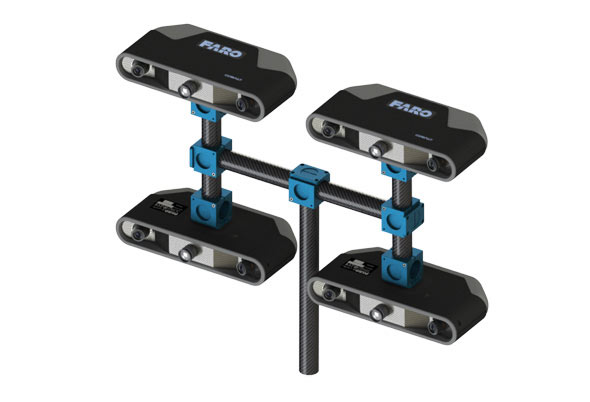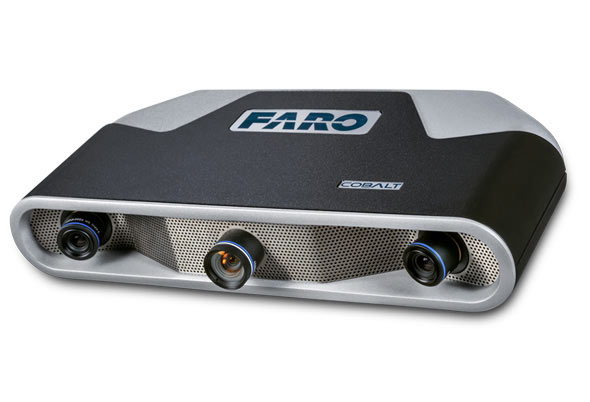Editor’s Pick: FARO Cobalt Array 3D Imager

Multiple arrays of FARO Cobalt Array 3D imagers can be positioned anywhere in a manufacturing process. In a multiple array configuration each imager scans simultaneously and all imagers are controllable with a single computer. Image courtesy of FARO Technologies Inc.
Latest News
February 24, 2016
Dear Desktop Engineering Reader:
 Sometimes items come over the newswires that you know hold the potential for a gobsmacking boost in productivity. Today’s Pick of the Week covers such an item. If your job means reverse engineering or quality inspections of parts, assemblies and tools, especially, but not exclusively, large items, this should interest you.
Sometimes items come over the newswires that you know hold the potential for a gobsmacking boost in productivity. Today’s Pick of the Week covers such an item. If your job means reverse engineering or quality inspections of parts, assemblies and tools, especially, but not exclusively, large items, this should interest you.
FARO Technologies recently released its FARO Cobalt Array 3D Imager. This non-contact scanner offers blue LED light projection technology, 5-megapixel stereo cameras and on-board processing. That dedicated processor is a very interesting characteristic of this device. More on it in a bit.
Another notable capability this imager brings to the shop floor is that you can configure an unlimited number of Cobalt imagers into an array where each unit simultaneously scans while you control the array on one computer. You don’t have to do that. You can use one Cobalt scanner.But that multi-unit capability means that you have options for scanning large products or assemblies efficiently that you might not have today. However you choose to configure the FARO Cobalt Array 3D Imager, you should be able to capture and process a gazillion 3D data points quickly, which leads us to the on-board processor.
FARO says that the Cobalt Array 3D Imager’s dedicated on-board processor is an industry first. They even have a patent pending on this feature. (Editor’s note: The developers of the Thor3D scanner, which was announced in August of last year, inform us that it has a built-in CPU and that the scanner is patented.) Basically, the processor enables a Cobalt Imager to calculate point-cloud data before it goes to your workstation. And what that means is that you get a consistent calculation speed with a device or an array that is designed to be easy to operate and simple to integrate into your processes.
The FARO Cobalt Array 3D Imager has other interesting attributes like user-configurable lenses for narrow or wide fields of view. Its HDR (high dynamic range) feature helps you measure both dark and light surfaces at the same time, and an automatic exposure functionality helps ensure optimal exposure settings for a given scanning job. As you might expect, the Cobalt Imager is inherently simpatico with FARO’s CAM2 Measure 10 software for 3D CAD and non-CAD inspection and GD&T (geometric dimensioning and tolerancing) applications.
 The FARO Cobalt Array 3D Imager combines blue LED light and digital projection technology with stereo cameras and on-board processing. An unlimited number of the imagers can be deployed in an array configuration controlled by a single computer. Image courtesy of FARO Technologies Inc.
The FARO Cobalt Array 3D Imager combines blue LED light and digital projection technology with stereo cameras and on-board processing. An unlimited number of the imagers can be deployed in an array configuration controlled by a single computer. Image courtesy of FARO Technologies Inc.The potential productivity boost here seems enormous. You can learn more about the FARO Cobalt Array 3D Imager in today’s Pick of the Week write-up. Make sure to hit the link to the video after the main write-up for a brief intro. Good stuff.
Thanks, Pal. – Lockwood
Anthony J. Lockwood
Editor at Large, Desktop Engineering
Subscribe to our FREE magazine, FREE email newsletters or both!
Latest News
About the Author
Anthony J. Lockwood is Digital Engineering’s founding editor. He is now retired. Contact him via [email protected].
Follow DE





